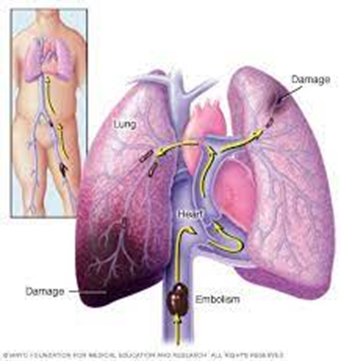A nurse is caring for a client who has a pulmonary embolism. The nurse should identify that the release of inflammatory mediators leads to which of the following pathologic findings?
Decreased pulmonary vascular resistance
Hypercapnia
Hypoventilation
Respiratory alkalosis
The Correct Answer is D
Correct answer: D
Choice A Reason:
Decreased pulmonary vascular resistance is incorrect. Inflammatory mediators released in response to a pulmonary embolism can lead to vasoconstriction and increased pulmonary vascular resistance. This is part of the body's response to redirect blood flow away from the affected area of the lung and maintain adequate perfusion to other areas.
Choice B Reason:
Hypercapnia is incorrect. Hypercapnia refers to elevated levels of carbon dioxide (CO2) in the blood. Hypocapnia usually is present with embolism; hypercapnia, on the other hand, is rare.
Choice C Reason:
Hypoventilation is incorrect. Hypoventilation occurs when there is inadequate ventilation of the lungs relative to metabolic demands. In the context of a pulmonary embolism, hypoventilation can occur due to factors such as pain, respiratory muscle fatigue, or impaired gas exchange, all of which can be influenced by the release of inflammatory mediators.
Choice D Reason:
Respiratory alkalosis is correct. In response to the blockage and the resulting inflammation, the body often increases the respiratory rate as a compensatory mechanism to maintain adequate oxygen levels and remove carbon dioxide. Due to the increased breathing rate, there is excessive exhalation of carbon dioxide, leading to a decrease in the partial pressure of CO2 in the blood. This results in an increase in blood pH, causing respiratory alkalosis.

Nursing Test Bank
Naxlex Comprehensive Predictor Exams
Related Questions
Correct Answer is C
Explanation
Choice A Reason:
Placing the client on clear liquids might not be appropriate in this situation because absent bowel sounds in the lower abdominal quadrants could indicate a more serious gastrointestinal issue such as ileus or bowel obstruction. Clear liquids may exacerbate these conditions and are not sufficient to address the underlying problem. Therefore, this option is not recommended until the cause of absent bowel sounds is identified and addressed.
Choice B Reason:
Performing a hemoccult blood test is not directly relevant to the situation described. Hemoccult tests are used to detect occult (hidden) blood in stool, which can be indicative of gastrointestinal bleeding. While it's important to assess for gastrointestinal bleeding in some cases, absent bowel sounds in the lower abdominal quadrants suggest a more immediate concern related to gastrointestinal motility rather than bleeding. Therefore, this option is not the most appropriate action at this time.
Choice C Reason:
Inserting a nasogastric tube is the most appropriate action in this scenario. Absent bowel sounds in a client with a spinal cord injury can indicate neurogenic bowel dysfunction, which may lead to abdominal distention and discomfort. Inserting a nasogastric tube can help decompress the stomach and intestines, reducing the risk of complications such as aspiration and providing relief from discomfort. It can also help manage gastrointestinal complications until further assessment and interventions can be implemented.
Choice D Reason:
Forcing the intake of fluids may not be appropriate without further assessment and could potentially worsen the client's condition if there is an underlying gastrointestinal issue leading to absent bowel sounds. Additionally, forcing fluids may not address the potential issue of gastrointestinal bleeding.
Correct Answer is ["A","B","D"]
Explanation
Choice A Reason:
Pupillary dilation is correct. Pupillary changes can indicate neurological dysfunction following a head injury. Dilated pupils may suggest increased intracranial pressure or damage to specific brain structures.
Choice B Reason:
Persistent headache is correct .Headaches are a common symptom following a head injury. Persistent or worsening headaches can indicate ongoing neurological issues and should be monitored closely.
Choice C Reason:
Presence of hand tremors is incorrect. Hand tremors are not typically associated with loss of consciousness following a motor vehicle accident. While hand tremors can occur in various conditions, such as essential tremor or Parkinson's disease, they are not typically a direct manifestation of a head injury. The primary concern immediately following a motor vehicle accident with loss of consciousness is assessing for signs of neurological dysfunction, such as altered level of consciousness, pupillary changes, and persistent headache. Hand tremors may be assessed in other contexts, but they are not directly related to the immediate assessment of a client following a motor vehicle accident with loss of consciousness.
Choice D Reason:
Difficulty waking is correct. Difficulty waking or altered level of consciousness can indicate neurological impairment and may be indicative of a concussion or other brain injury.
E. Foot drop is incorrect. Foot drop refers to difficulty lifting the front part of the foot, which can cause dragging of the foot or toes along the ground while walking. While foot drop can result from various neurological conditions or injuries, it is not typically associated with loss of consciousness following a motor vehicle accident. Loss of consciousness after a motor vehicle accident is more indicative of potential head trauma or concussion, which may present with symptoms such as altered level of consciousness, headache, pupillary changes, or difficulty waking. Foot drop would be more relevant to assess in contexts related to peripheral nerve injury, spinal cord injury, or neurological conditions affecting the lower extremities. Given the scenario provided, foot drop is not a typical manifestation that the nurse would assess for immediately following a motor vehicle accident with loss of consciousness. Therefore, option E is not relevant in this scenario.
Whether you are a student looking to ace your exams or a practicing nurse seeking to enhance your expertise , our nursing education contents will empower you with the confidence and competence to make a difference in the lives of patients and become a respected leader in the healthcare field.
Visit Naxlex, invest in your future and unlock endless possibilities with our unparalleled nursing education contents today
Report Wrong Answer on the Current Question
Do you disagree with the answer? If yes, what is your expected answer? Explain.
Kindly be descriptive with the issue you are facing.
